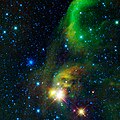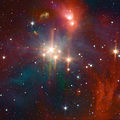User:Sadalsuud/sandbox
Circumstellar dynamics[edit]
In the late phase of stellar evolution, massive stars like Betelgeuse exhibit high rates of mass loss, possibly as much as 1 M☉ every 10,000 years, resulting in a complex circumstellar environment that is constantly in flux.[1] In a 2009 paper, stellar mass loss was cited as the "key to understanding the evolution of the universe from the earliest cosmological times to the current epoch, and of planet formation and the formation of life itself.[2] However, the physical mechanism is not well understood.[3] When Schwarzschild first proposed his theory of huge convection cells, he argued it was the likely cause of mass loss in evolved supergiants like Betelgeuse. Recent work has corroborated this hypothesis, yet there are still uncertainties about the structure of their convection, the mechanism of their mass loss, the way dust forms in their extended atmosphere, and the conditions which precipitate their dramatic finale as a type II supernova.[3] In 2001, Graham Harper estimated a stellar wind at 0.03 M☉ every 10,000 years, but research since 2009 has provided evidence of episodic mass loss making any total mass loss figure for Betelgeuse uncertain. Current observations suggest that a star like Betelgeuse may spend a portion of its lifetime as a red supergiant, but then cross back across the H-R diagram, pass once again through a brief yellow supergiant phase and then explode as a blue supergiant or Wolf-Rayet star.
In the late phase of stellar evolution, massive stars like Betelgeuse exhibit high rates of mass loss, possibly as much as 1 M☉ every 10,000 years, although realistic estimates are close to 0.03 M☉ over the same timeframe.[4] This lost material forms a complex circumstellar environment that is constantly in flux.[1] In a 2009 paper, stellar mass loss was cited as the "key to understanding the evolution of the universe from the earliest cosmological times to the current epoch, and of planet formation and the formation of life itself."[2] However, the physical mechanism is not well understood.[3] When Schwarzschild first proposed his theory of huge convection cells, he argued it was the likely cause of mass loss in evolved supergiants like Betelgeuse. Recent work has corroborated this hypothesis, yet there are still uncertainties about the structure of their convection, the mechanism of their mass loss, the way dust forms in their extended atmosphere, and the conditions which precipitate their dramatic finale as a type II supernova.[3] Current observations suggest that a star like Betelgeuse may spend a portion of its lifetime as a red supergiant, but then cross back across the H-R diagram, pass once again through a brief yellow supergiant phase and then explode as a blue supergiant or Wolf-Rayet star.
Corona Australis Molecular Cloud[edit]
| Nebula | |
|---|---|
 Map showing the location and boundaries of the CrA molecular cloud complex. | |
| Observation data: J2000.0 epoch | |
| Right ascension | 19h 01m 51s[5] |
| Declination | –36° 58.9′[5] |
| Distance | 425 ly (130 pc) ly |
| Apparent dimensions (V) | 16.0° × 6.5° |
| Constellation | Corona Australis |
| Physical characteristics | |
| Radius | 8 ly ly |
| Designations | CrA Dark Cloud, CrA MCLD, CrA region |
At a distance of 130 parsecs (~420ly), lies a dark nebula of gas and dust known as the Corona Australis molecular cloud, one of the nearest star formation regions from Earth. Sometimes referred to as the CrA Dark Cloud or simply the CrA Cloud, it hosts several reflection nebulae − NGC 6729, NGC 6726/6727, and IC 4812 being the most notable.[6] The globular cluster known as NGC 6723, which in photographs appears close by, is actually 29,000ly away, and so not part of the region.[7] The cloud is located in the constellation Corona Australis, close the border of Sagittarius, between Gamma CrA and Epsilon CrA and stretches roughly 8ly across.
The cloud is located at about 18% below the galactic plane and covers an angular area of 16.0° × 6.5° on the celestial sphere.[8] Temperatures of the clouds range from 13–22 K, and there is a total of about 7,000 times the mass of the Sun in material. Over half of the mass of the complex is concentrated around ___________________, and this is the most active star-forming region. There are embedded infrared sources within the complex. A total of 425 infrared sources have been detected near the L1688 cloud. These are presumed to be young stellar objects, including 16 classified as protostars, 123 T Tauri stars with dense circumstellar disks, and 77 weaker T Tauri stars with thinner disks. The last two categories of stars have estimated ages ranging from 100,000 to a million years.

Known to exhibit significant extinction, as high as 45 magnitudes at visual wavelengths (AV∼45 mag), astronomers have now identified 55 distinct optical members within the CrA Cloud.[8] At the core is the Coronet protostar cluster, a loose collection of about 30 young stars with a wide range of masses at various stages of evolution.[9] Surrounding the cluster are a few late stage B stars, numerous Herbig–Haro objects, and several YSOs. At the opposite end of the mass spectrum, are two confirmed brown dwarfs along with seven more candidates. There are also many embedded infrared sources within the complex. The molecular cloud has been most widely surveyed in the infrared, X-rays, radio waves and in the millimeter continuum.
Source data[edit]
Chandra 2007[9]
ESO 1109[10]
ESO 1027[11]
Hass 2008[12]
Malin2010[6]
Martín 2001[13]
NASA 2010[7]
Neuhäuser 2008[8]
Peterson 2010[14]
Wang 2004[15]
In the north of the constellation is the Corona Australis Molecular Cloud, a dark molecular cloud with many embedded reflection nebulae, including NGC 6729, NGC 6726–7, and IC 4812. A star-forming region of around 7000 M☉,[16] it contains Herbig–Haro objects, T Tauri stars with dense circumstellar disks, (protostars) and some very young stars. Located about 430 light years (130 parsecs) away, it is one of the closest star-forming regions to our solar system.[17] The related NGC 6726 and 6727, along with unrelated NGC 6729, were first recorded by Johann Friedrich Julius Schmidt in 1865.[18]
Gallery[edit]
-
The R CrA region at the heart of the CrA Dark Cloud.
-
Star-forming region NGC 6729 showing the dramatic birth of very young stars.
-
Infrared photo of the Coronet Cluster within the R CrA region. R CrA is the bright star in the center.
References[edit]
- ^ a b Cite error: The named reference
ESO0927was invoked but never defined (see the help page). - ^ a b Ridgway, Stephen; Aufdenberg, Jason; Creech-Eakman, Michelle; Elias, Nicholas; et al. (2009). "Quantifying Stellar Mass Loss with High Angular Resolution Imaging". Astronomy & Astrophysics. 247: 247. arXiv:0902.3008. Bibcode:2009astro2010S.247R.
- ^ a b c d Cite error: The named reference
KERVELLA2011was invoked but never defined (see the help page). - ^ Cite error: The named reference
HARPER2001was invoked but never defined (see the help page). - ^ a b "CRA DARK CLOUD -- Molecular Cloud". SIMBAD. Centre de Données astronomiques de Strasbourg. Retrieved 2012-09-01.
- ^ a b Malin, David (August 2010). "The Corona Australis nebula (NGC 6726-27-29)". Australian Astronomical Observatory. Retrieved 2012-09-02.
- ^ a b Jet Propulsion Laboratory (2010). "PIA13064: Star Clusters Young and Old, Near and Far". NASA/IPAC Extragalactic Database. California Institute of Technology/National Aeronautics and Space Administration. Retrieved 4 September 2012.
- ^ a b c Neuhäuser, R.; Forbrich, J. (December 2008). "The Corona Australis Star Forming Region". Handbook of Star Forming Regions. II: 735. arXiv:0808.3374v1. Bibcode:2008hsf2.book..735N.
{{cite journal}}: CS1 maint: date and year (link) CS1 maint: multiple names: authors list (link) - ^ a b "Coronet: A Star Formation Neighbor". Chandra Multimedia Features. NASA. 2007-09-13. Retrieved 2012-09-02.
- ^ "The Drama of Starbirth". Press Releases. European Southern Observatory. 16 March 2011. Retrieved 2012-09-02.
- ^ "R Coronae Australis: A Cosmic Watercolour". Press Releases. European Southern Observatory. 30 June 2010. Retrieved 2012-09-02.
- ^ Haas, M.; Heymann, F.; Domke, I.; Drass, H.; Chini, R.; Hoffmeister, V. (September 2008). "A near-infrared survey of the entire R Coronae Australis cloud". Astronomy and Astrophysics. 488 (3): 987–996. arXiv:0807.2594v1. Bibcode:2008A&A...488..987H. doi:10.1051/0004-6361:200809949.
{{cite journal}}: Unknown parameter|class=ignored (help)CS1 maint: date and year (link) CS1 maint: multiple names: authors list (link) - ^ Martín, E. L. (2001). Hugh R. A. Jones and Iain A. Steele (ed.). Spectroscopy of Young Brown Dwarfs and Isolated Planetary Mass Objects. Springer. pp. 153–167. ISBN 978-3-540-42353-9.
{{cite book}}: Unknown parameter|book-title=ignored (help) - ^ Peterson, Dawn E.; GTO Spitzer, IRAC; Gould Belt Legacy Team (January 2010). "Young Stellar Objects Identified with Spitzer in Corona Australis" (PDF). American Astronomical Society, AAS Meeting #215, #429.35;. 42 (published Bulletin of the American Astronomical Society): 355. Bibcode:2010AAS...21542935P. Retrieved 2012-09-02.
{{cite journal}}: Check date values in:|publication-date=(help)CS1 maint: date and year (link) CS1 maint: extra punctuation (link) CS1 maint: multiple names: authors list (link) - ^ Wang, Hongchi; Mundt, Reinhard; Henning, Thomas; Apai, Dániel (December 2004). "Optical Outflows in the R Coronae Australis Molecular Cloud" (PDF). The Astrophysical Journal, Volume 617, Issue 2, Pp. 1191-1203. 617 (2): 1191–1203. Bibcode:2004ApJ...617.1191W. doi:10.1086/425493. Retrieved 2012-09-02.
{{cite journal}}: CS1 maint: date and year (link) CS1 maint: multiple names: authors list (link) - ^ Kaler, Beta Coronae Australis.
- ^ Reipurth 2008, p. 735.
- ^ Steinicke 2010, p. 176.
External links[edit]
- 2011 June 27: Stars and Dust Across Corona Australis
- 2007 Sept 21: Coronet in the Southern Crown
- 2002 Oct 2: Star Clouds Toward the Southern Crown
Experimental Gallery[edit]
-
Rho Ophiuchi molecular cloud complex in Ophiuchus.
-
Award winning photo of Orion.
Old Table[edit]
| Parameter | Star Data | |||||||||||
|---|---|---|---|---|---|---|---|---|---|---|---|---|
| Name | β Aqr A | β Aqr B | β Aqr C | |||||||||
| Class | G0Ib | |||||||||||
| Magnitude | 2.91 | 11.0 | 11.6 | |||||||||
| RA | 21h 31m 33.5s | 21h 31m 31.9s | 21h 31m 33.0s | |||||||||
| Dec | −05° 34′ 16″ | −05° 33′ 46″ | −05° 35′ 10″ | |||||||||
| Plx (err) | 5.33 (0.94) | |||||||||||
| LY | 610 | |||||||||||
| Parameter | Star Components | |||||||||||
| AB | AC | |||||||||||
| Year Observed | 1879 | 1947 | 1877 | 1915 | ||||||||
| Measurements | 12 | 7 | 9 | 6 | ||||||||
| PA | 319° | 321° | 186° | 186° | ||||||||
| A/D | 34.3" | 35.4" | 54.5" | 57.2" | ||||||||
| Discoverer Designations | H 76 | BU 75 | ||||||||||
Currency Table[edit]
I believe that the recent redesign of this list is a step in the wrong direction. Here's why:
- The original "List of Market Opening Times" was focused on opening times. This new list has lost that focus, thereby making this list less useful.
- As a currency trader, the prior list was far more useful as it was sorted by opening times. With a 24-hour forex market and the fact that currency movements are highly correlated with the open and close of their respective equity and futures markets, the previous list
- By incorporating many new fields (1) Rank, 2) Economy 3) Headquarters 4) Market Capitalization 5) Year to date Trade Value), it has added a lot of superfluous information making the list unwieldy. Anyone who wanted that extra information could have easily retrieved it by clicking on the respective links for each stock exchange, or going to other lists.
- Sorting by Market Cap has nothing to do with opening times. It has to do with Market cap.
- The previous list incorporated many more markets and was growing









